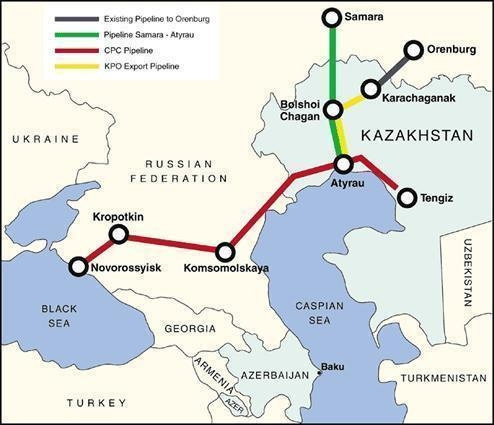From January to August 2022, ~40% of Russian crude exports were shipped from Russia’s Black Sea port: Novorossiysk. This warm water port, often referred to as “NSP” (for “Novorossiysk Sea Port”) is the largest of Russia's 7 major ports, and is home to a naval base, shipbuilding yards, and… an oil-pipeline terminal.
Vessels calling at the port include containerized cargo, bulk carriers, and oil tankers. Of the tankers, about 2/3 are crude oil tankers and 1/3 are clean petroleum product tankers or chemical tankers.
NSP is also the terminus of a 1,500—kilometer pipeline which runs from the rich Tengiz Oil Field in western Kazakhstan. More than two-thirds of Kazakhstan’s high quality crude oil exports go through the CPC pipeline.
This year, NSP crude exports were shipped mostly to the EU, Turkey, and Israel. Officially, the oil goes no further…but is that true?
Increasingly the oil is loaded onto a second tanker via ship-to-ship transfer, to be sent to Chinese and Indian refineries…only to be exported back to the West, once the provenance of the Russian crude has been sufficiently obscured.
You will notice that the majority of vessel names above are Greek — no coincidence. Among publicly—listed names, vessels belonging to Tsakos Energy Navigation Ltd. TNP 0.00%↑ and Okeanis Eco Tankers $OET stick out. In other data I noticed many Scorpio Tankers STNG 0.00%↑ vessels calling at NSP as well. And when you look at the Worldscale numbers in the “Rate” column, above (a standardized estimate of the cost) you will notice that the numbers are going higher as time goes on… so the incentives are clear.
As Robert Bugbee of Scorpio Tankers has pointed out repeatedly in interviews, it is not illegal to carry Russian oil and CPP: “We are lifting Russian diesel at the moment. If the government sanctions a position, we will abide to that 100%. You have to assume that the governments are doing this for a reason.”
Here is an excerpt from an interview with Lloyd's List on 22 September 2022:
Such choices are not without consequences, however. Many argue that by accepting to carry Russian crude oil and refined products, that publicly-listed tanker companies are helping fund Russia’s war machine in Ukraine. Prominent former analyst and Cleaves Shipping Fund manager Joakim Hannisdahl divested his investments in Tsakos and Okeanis, making the following comment:
Zooming in on the “oil tanker allocation” chart from the above tweet, Hannisdahl signals which companies he is boycotting by indicating “0%” in the pie chart, namely: Scorpio Tankers STNG 0.00%↑, Tsakos TNP 0.00%↑ , Okeanis $OET, Hunter Group $HUNT, and Nordic American Tankers NAT 0.00%↑ .
For relatively illiquid securities such as retail favorite Okeanis — which trades an average of just 65,000 shares per day @ ~$14.00, and is listed via the Oslo exchange, which is inaccessible for many investors — these public castigations can have a material impact. Many retail and even institutional investors take signals from such experts seriously and follow suit.
Where will Russian oil go, once the EU embargo on Russian crude oil takes effect on 5 December 2022? Much, much farther away. That is precisely what oil tanker executives and investors are so excited about. With the increase in “ton miles” (a measure of both the volume shipped, and the distance it travels), the amount of available tankers at any time will be artificially limited. And as Sergey Vakulenko has written, “The design of the European sanctions clearly signals that there is a plan to keep these measures in place for years, if not forever.”
You know what that means?











Very good article, please keep following this topic. I am interested to see what happens as we get close to dates of real sanctions, and the interplay with some of the ideas to let this oil flow- provided it's at a low price.